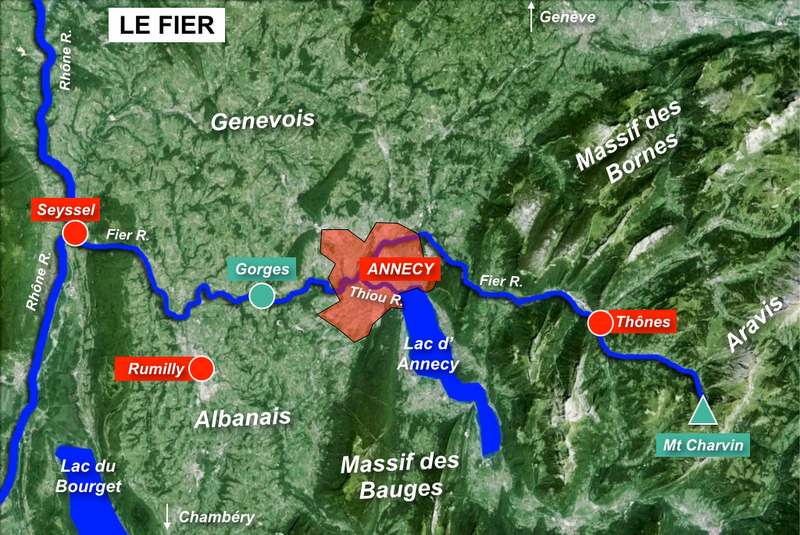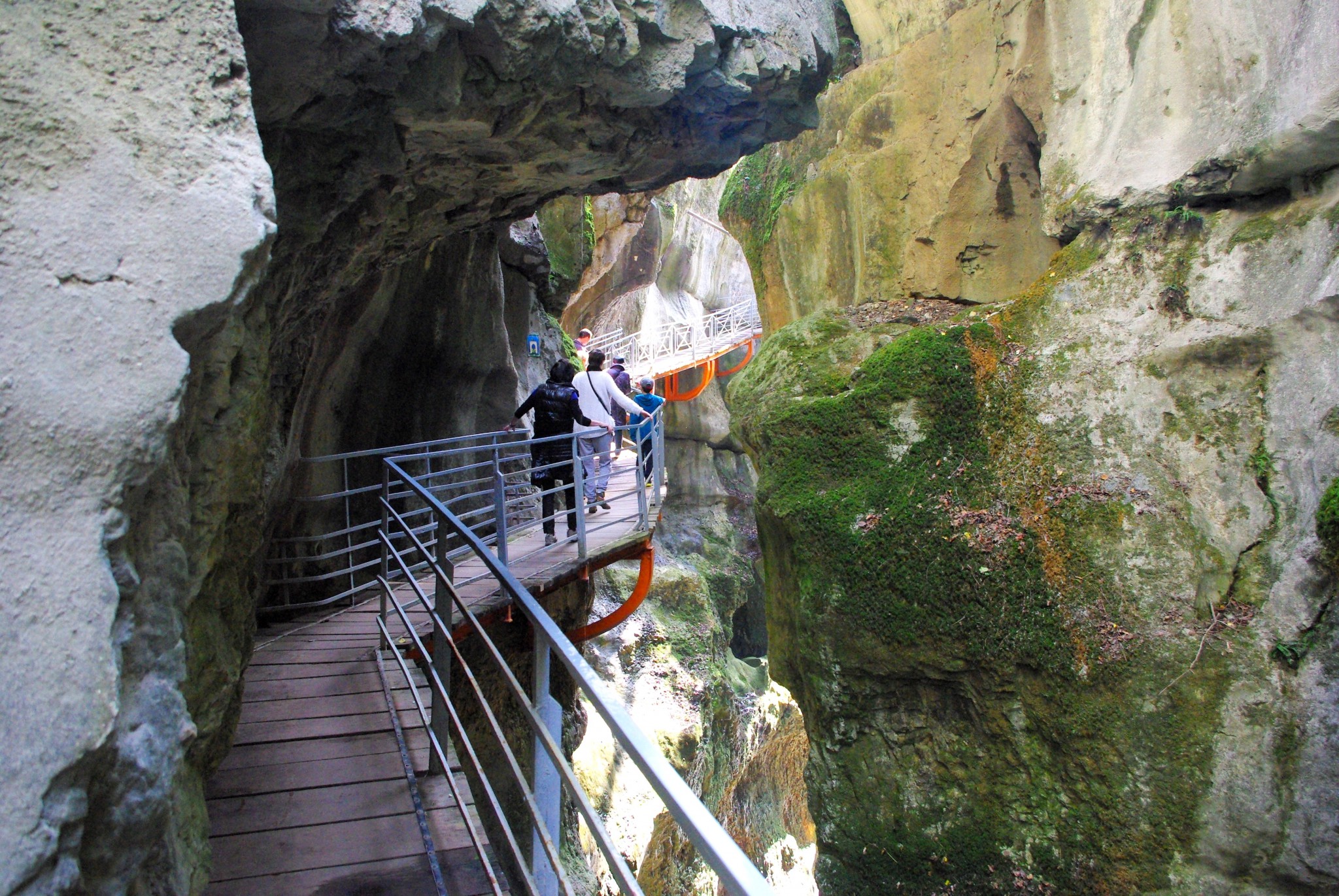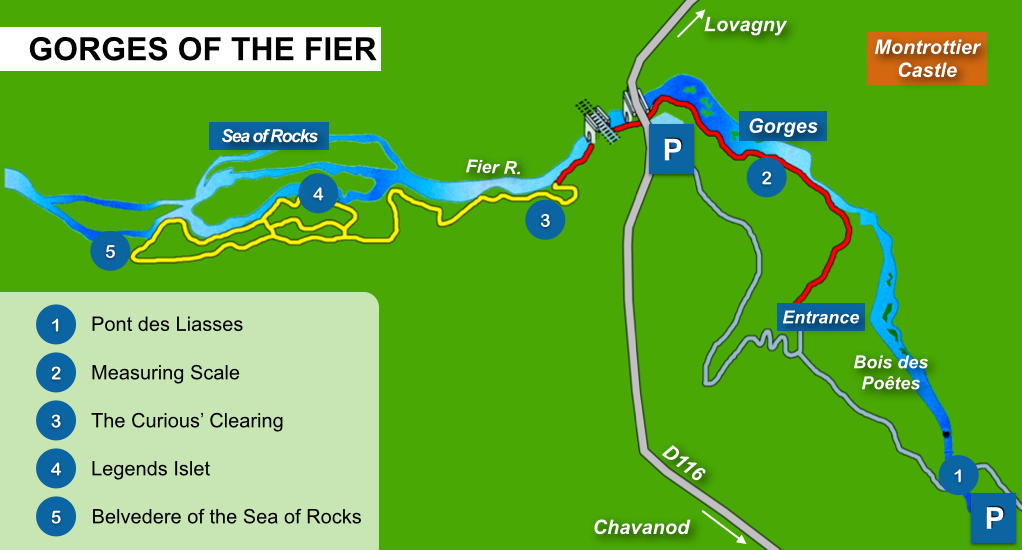The Gorges of the Fier are a spectacular natural wonder on the doorstep of Annecy. Situated at the foot of the medieval castle of Montrottier, the deep, narrow gorges are one of the oldest tourist sites of the Alps. Since 1869 a suspended footbridge, perched above the stream, has been erected to enable visitors to explore the gorges.
The Fier River
The Fier River runs through the Haute-Savoie and Savoie départements. It has its sources at Mount Charvin in the Aravis Range and flows 71.9 km before it empties into the Rhône at Seyssel.

Along the way, it passes through the valleys of Manigod, the little town of Thônes and crosses the narrow pass of Dingy-Saint-Clair before reaching the suburbs of Annecy. From there, it tumbles through the rocky gorge known as the Gorges of the Fier.
Its main tributaries are the Nom, the Filière, the Thiou, the Viéran, and the Chéran. Lake Annecy also feeds the Fier, via the Thiou, thus ensuring a relatively constant source of water.
The Gorges of the Fier
The Gorges of the Fier are situated in Lovagny, 10 km from Annecy.
Over a period of thousands of years, erosion slowly carved out the gorges, accentuated by the formation of numerous potholes.
The suspended footbridges were completed in July 1869. Workers were transported inside barrels moved via a system of pulleys to fix solid metallic consoles into the rock walls.
The track is suspended some 20 to 30 metres above and stretches 252 metres over the stream.
The visible strata of the gorges are composed of sedimentary limestone rocks which vary widely in appearance and composition, from grey to a yellowish colour, partly covered with mosses and other organic particles.

Visit of the Gorges
Situation map of the gorges:

From the main car park, a path crosses the Fier at Pont des Liasses and follows the banks of the stream through the “Bois du Poête” (the Poet’s Wood).
At the end of the pathway, the kiosk (souvenir shop, bar and terrace) marks the entrance to the site.
At the beginning of the 252-metre long walk, the footbridge turns left between two gigantic limestone pillars forming the ‘Portail’ and enters the narrow gorges.
At the top of the vertical cliffs, a verdant canopy dims the light on the rocks and the stream below. Some of the rocks emerge from the stone chiselled by water, wind and time with shapes resembling a fantastic animal or a man’s face.
During heavy rain, the water can rise 26 metres in a matter of hours. Halfway along the footbridge, a measuring scale on the rock face indicates the water levels reached in times of flood. On 30 September 1960, the waters rose over 27 metres.
Towards the end of the walk, the arches of two bridges can be seen above: the first is the D116 road from Chavanod to Lovagny and the second is the railway line from Annecy to Chambéry.
At the exit, a few steps lead to plain daylight at the “Clairière des Curieux” (the Curious’ Clearing) where several informative panels give ample explanations about the site.
Walking the length of the gorges on the footbridge, clinging to the sheer rock cliff over the stream, provides a fascinating outing for all ages. Parents and accompanying adults must ensure children never climb the guard rails and fences. The site is not accessible for pushchairs but a baby carrier is a good alternative). It is advisable to wear closed shoes (ideally flat ones) and warm clothes in spring and autumn. Even if you are not good with heights, the fantastic walkway feels safe.
The Gorges du Fier is open daily from 15 March to 15 October, the hours varying depending on the time of year. In 2014, admission is €5.50 for adults and €3 for children 7-15 and free for children under 7. Different rates apply to groups (check here).
The Sea of Rocks
Beyond the exit of the gorges is a belvedere on a rocky promontory. It gives a good view over the “Mer de Rochers” (Sea of Rocks).
Water and erosion have carved and shaped this cluster of boulders which resemble the waves of the sea. The Fier runs through a labyrinth of fissured limestone rocks in many canals. In some parts, the water’s convective action has eroded the base of the rock faces, thus forming the tops. This natural formation is called ‘convection niches’.
Halfway through, the little rocky spur of “Îlot des Légendes” (Legends Islet) has panels telling local legends from the Middle-Ages.
The legend of the Gorges du Fier
The fantastic site of the gorges has its own local legend, told to generations of children since medieval times.
Once upon a time, in the castle just above the gorges, lived a beautiful young countess named Diane. She was married to the rich and powerful Count of Montrottier. Finding herself abandoned by her husband more and more often, Diane often walked near the gorges with her loyal page, a devoted young man who was secretly in love with her. One day, they met a handsome knight who happened to be the Count of Pontverre, her husband’s rival.
One day, the young page discovered that Diane was having an affair with Pontverre. Furious and heartbroken, the page reported the affair to the Count of Montrottier who set a trap at the Gorges of the Fier to catch the two lovers in the act. When the Count of Pontverre was discovered, he ran away and the young page pursued him. The trap went horribly wrong as the young page fell into the gorges.
Ever since then, children are told that on certain clear summer nights, local villagers hear the sound of wailing intermingled with the rushing of the waters rising up from the bottom of the gorges. These are believed to be the plaintive voice of the young page who mourns his lost love.
The Castle of Montrottier
Set high above the gorge on an isolated hill, the castle of Montrottier was built between the 13th and 16th centuries in typical Savoyard military architectural style and was restored in the 19th century.
In the Middle-Ages, the fortress used to guard the route of Geneva to Chambéry.
The castle has a pentagonal shape arranged around the cylindrical keep tower with battlements. From the top of the 36m tower, the fine views extend over the surrounding hills of the Albanais region and the Alps: the Parmelan, Mount Veyrier (and behind it a small part of Mont-Blanc), the Dents de Lanfon and the Tournette mountain.
Inside the castle, the vast collections bequeathed in 1916 by art collector Léon Marès to the Académie Florimontane are displayed: weaponry, earthenware, china, ceramics, tapestries, antique furniture and rare artefacts from Africa and the Far-East. It also includes four bronze bas-reliefs by Hans and Peter Vischer of Nuremberg from the 16th century.
Find out more about the Montrottier Castle here.
English-French Vocabulary
(f) for féminin, (m) for masculin, (adj) for adjective and (v) for verbs
- Alps = Alpes (f,p)
- bridge = pont (m)
- castle = château (m)
- clearing = clairière (f)
- cliff = falaise (f)
- convection niche = niche de convection (f)
- entrance = entrée (f)
- footbridge = passerelle (f)
- gorge = gorge (f)
- keep = donjon (m)
- legend = légende (f)
- limestone = calcaire (m)
- portal = portail (m)
- pothole = marmite de géant (f)
- rail = rampe (f)
- river = rivière (f)
- rock = rocher (m)
- sea = mer (f)
- stone = pierre (f)
- stream = ruisseau (m)
- tower = tour (f)
- valley = vallée (f)
- wonder = merveille (f)
- wood = bois (m)
Visit the Annecy Tourist Office website here.
Find out more about the Gorges of the Fier here.



